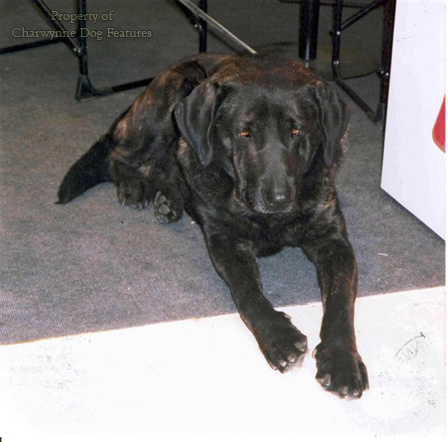716 LOST GUNDOGS THE LABRADOR DOG FROM DEVON
THE LOST GUNDOGS FROM THE COUNTIES:
The Labrador Dog from Devon and the Norfolk Dogs
by David Hancock
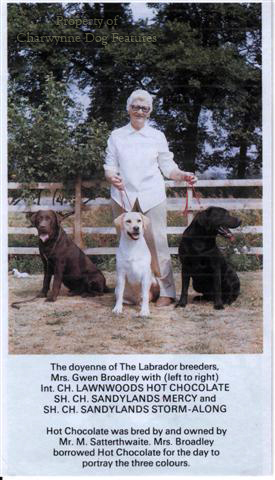

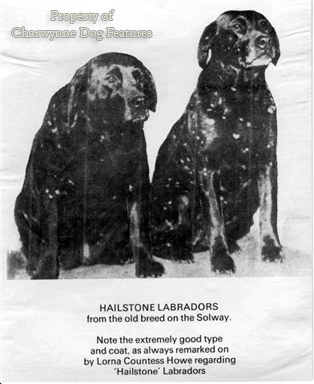

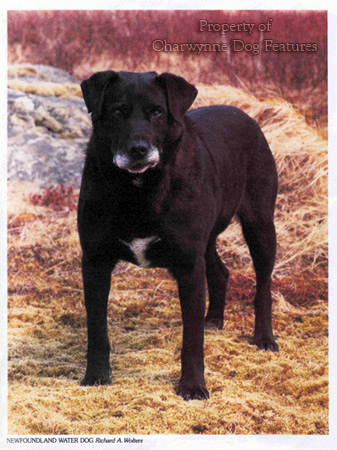
In his valuable work, Dog Breaking of 1876, General Hutchinson gave this opinion: "...it is usually allowed that, as a general rule, the best land retrievers are bred from a cross between the Setter and the Newfoundland, or the strong Spaniel and the Newfoundland...the far slighter dog reared by the settlers on the coast, a dog that is quite as fond of water as of land..." This 'far slighter dog' indicates the variety of type found in the early imports from Newfoundland and it was the lighter-coated lighter-built dog that caught the eye of the second and third Earls of Malmesbury, the fifth and sixth Dukes of Buccleuch and the eleventh and twelth Earls of Home, who had the vision to see the sporting potential of the Labrador retriever, now our most popular breed of dog. The Earls of Malmesbury lived at Heron's Court, only four miles from Poole, where the ships came in from Newfoundland. They soon realised the value of the black, biddable seal-coated ship’s dogs that came ashore there. But were we merely importing a British export, the black smooth-coated ship’s dog from Devon? The American gundog expert Richard Wolters certainly thought so.
In his intriguing book The Labrador Retriever – The History…The People, published in 1981 by Petersen Prints of Los Angeles, Wolters describes the settlement of Avalon, a peninsula in Newfoundland, which even in the 16th century had 250 ships and around 10,000 fishermen eventually employed there, who came, with their dogs – out of Devonshire. He is supported by Middleton and Scott’s The Labrador Dog – Its Home and History, which states: ‘…there is good reason for supposing that one of the earlier ancestors must have been the hunting dog of the Devon fishermen…of greater antiquity than the large Newfoundland dog’ and points out that the settlement on the Avalon peninsula expanded over the next two centuries and the strong black all-purpose dogs spread outwards too. These dogs were used in a wide variety of ways, pulling fishmongers’ carts, hauling fishing nets up beaches and retrieving lost ships’ lines, just as they were in Devon. But then, another North American breed, the Chesapeake Bay Retriever may well have come from the county of Norfolk!
In his book British Dogs of 1888, Hugh Dalziel, kennel editor of 'The Country' magazine, exhibitor and judge, produced a chapter on the Norfolk Retriever. He largely relied on the knowledge of 'Saxon', a Norfolk sportsman, who provided 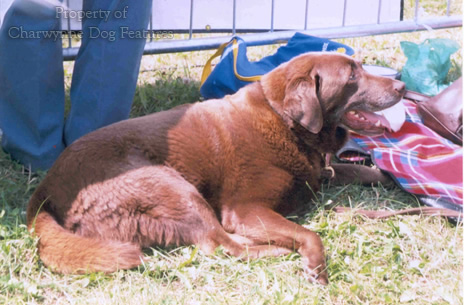 the text. Dalziel acknowledged that "although Retrievers answering this description may be more plentiful in Norfolk than elsewhere, they are met with often enough in all parts of the country." 'Saxon' describes the coat colour of this retriever as: "...more often brown than black, and the shade of brown rather light than dark -- a sort of sandy brown, in fact." He goes on to describe the coat as looking 'rusty', inclined to be coarse, feeling harsh to the touch, curly but not as close and crisp as in the Curly-coated Retriever of the show ring, tending to be open and woolly. He describes a saddle of straight short hair across the back. Gamekeepers usually docked their tails which made them appear to some sporting writers as spaniels, despite their stature.
the text. Dalziel acknowledged that "although Retrievers answering this description may be more plentiful in Norfolk than elsewhere, they are met with often enough in all parts of the country." 'Saxon' describes the coat colour of this retriever as: "...more often brown than black, and the shade of brown rather light than dark -- a sort of sandy brown, in fact." He goes on to describe the coat as looking 'rusty', inclined to be coarse, feeling harsh to the touch, curly but not as close and crisp as in the Curly-coated Retriever of the show ring, tending to be open and woolly. He describes a saddle of straight short hair across the back. Gamekeepers usually docked their tails which made them appear to some sporting writers as spaniels, despite their stature.
These dogs were the wildfowlers' retrievers, used "on broad, river, sea-coast and estuary". It was alleged that the Pointer was not hard enough for such work, the water spaniel too impetuous but the Norfolk Retriever "will face a rough sea well, and they are strong swimmers, persevering, and not easily daunted in their search for a dead or wounded fowl." 'Saxon' claims that Norfolk was outside 'the magic circle of shows' and so the 'improvement' of them has not taken place. He makes it quite clear that this Norfolk dog is different from a spaniel (and appreciably larger) and from the Curly-coated, Flat-coated and Labrador Retrievers.
If you tried to find the contemporary retriever breed to fit closest to the description of the Norfolk Retriever,  then the Chesapeake Bay Retriever would be my choice. The breed standard of the latter describes the coat as "harsh...hairs having a tendency to wave on neck, shoulders, back and loins...straw/bracken coloured, red-gold (sedge) or any shade of brown...White spots on chest, toes and belly permissible. The smaller the spot the better." The Norfolk Retriever featured white in the form of a spot on the chest. 'Saxon' stated that the most distinctive features of the Norfolk Retriever were its unique coat and its quite remarkable hardiness. The first sentence of the Chesapeake's standard mentions its distinctive coat and lists one of its characteristics as courageous with a great love of water.
then the Chesapeake Bay Retriever would be my choice. The breed standard of the latter describes the coat as "harsh...hairs having a tendency to wave on neck, shoulders, back and loins...straw/bracken coloured, red-gold (sedge) or any shade of brown...White spots on chest, toes and belly permissible. The smaller the spot the better." The Norfolk Retriever featured white in the form of a spot on the chest. 'Saxon' stated that the most distinctive features of the Norfolk Retriever were its unique coat and its quite remarkable hardiness. The first sentence of the Chesapeake's standard mentions its distinctive coat and lists one of its characteristics as courageous with a great love of water.
Some authorities have claimed that the Chesapeake Bay Retriever was developed from two ship-wrecked so-called ‘Newfoundlands’ (one black, one red, which were never mated together; the red one only threw blacks) and others from 'Red Winchester' water-dogs out of Ireland. The American writer, Bede Maxwell, in her forthright The Truth about Sporting Dogs of 1972, thought this link might be with a fisheries patrol vessel HMS Winchester which sailed out of Cork to the eastern American seaboard, with officers taking their Irish Water Spaniels with them. But Newfoundlands and Irish Water Spaniels have distinct anatomical differences from Chesapeakes. And, just as I suspect that the Nova Scotia Duck-tolling Retriever was taken to Canada as the red decoy dog of England, especially from the East Anglia part of England, so too could the Norfolk Retriever. Perhaps some diligent breed researcher could look at the records in Norfolk, Virginia, at the entrance to Chesapeake Bay itself.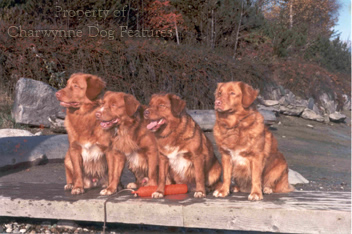
If my theory is correct then the great sporting county of Norfolk has missed out in several ways concerning the titles of sporting gundogs. For just as the Norfolk Retriever could be behind the Chesapeake Bay Retriever and renamed in its new country, so too could the English Springer Spaniel have been named the Norfolk Spaniel and the Nova Scotia Duck-tolling Retriever called the Red Norfolk Decoy Dog. In Britain, we respected the backgrounds of both the Newfoundland, which could so easily have become the Landseer Retriever, and the Labrador, which could so easily have become the Malmsbury Retriever, from its early development in England. We lost our Tweed Water Spaniel and English Water Spaniel; the Americans still have their Boykin Spaniel and American Water Spaniel.
In his The Illustrated Book of the Dog of 1880, Vero Shaw felt obliged to mention the Norfolk Retriever and wrote that: "It is claimed for this breed...that it is peculiarly adapted for the pursuit of wild birds in the low-lying districts of Norfolk, and that few, if any other varieties of dog, could be found to endure the hard work equally well." In his Breaking and Training Dogs of 1910, 'Pathfinder' wrote of .jpg) retrievers: "...I have known livers in Norfolk dignified with that prefix, just as it was usual at one time to speak of the English Springer when met there as the Norfolk Spaniel." In his The Sporting Dog, published in New York in 1904, the American writer, Joseph A Graham, stated that: "The Chesapeake is not so peculiar or distinct. In fact, he is of rather common appearance. Stout and strong, sedge or rusty brown in color, the coat dense and close, he is not a beauty."
retrievers: "...I have known livers in Norfolk dignified with that prefix, just as it was usual at one time to speak of the English Springer when met there as the Norfolk Spaniel." In his The Sporting Dog, published in New York in 1904, the American writer, Joseph A Graham, stated that: "The Chesapeake is not so peculiar or distinct. In fact, he is of rather common appearance. Stout and strong, sedge or rusty brown in color, the coat dense and close, he is not a beauty."
So we have a rusty-coloured, broken-coated, retriever-sized dog in Norfolk, England and subsequently an identical dog near Norfolk, Virginia, at the mouth of Chesapeake Bay. The dog in England is not recognised as a breed, Vero Shaw hinting that it was to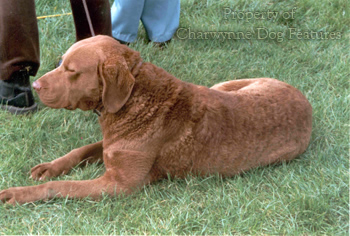 o nondescript for that to happen. Joseph Graham describes the dog in America as 'of rather common appearance' but it becomes recognised as a breed nevertheless. In his The Dog of 1880, the respected 'Idstone' wrote "Liver and sandy Retrievers have a few partisans. They are the sort which 'always were kept', people tell you, 'in our family'...I know of no family priding itself on this coloured species just now, but I have heard that they are not uncommon in Norfolk." It may be far too late to have the Labrador renamed the Devon Retriever. But how worthwhile a venture it would be to find rusty-coloured, broken-coated retrievers 'not uncommon in Norfolk', however nondescript, once again recognized, and this time registered, as a Norfolk gundog breed.
o nondescript for that to happen. Joseph Graham describes the dog in America as 'of rather common appearance' but it becomes recognised as a breed nevertheless. In his The Dog of 1880, the respected 'Idstone' wrote "Liver and sandy Retrievers have a few partisans. They are the sort which 'always were kept', people tell you, 'in our family'...I know of no family priding itself on this coloured species just now, but I have heard that they are not uncommon in Norfolk." It may be far too late to have the Labrador renamed the Devon Retriever. But how worthwhile a venture it would be to find rusty-coloured, broken-coated retrievers 'not uncommon in Norfolk', however nondescript, once again recognized, and this time registered, as a Norfolk gundog breed.
